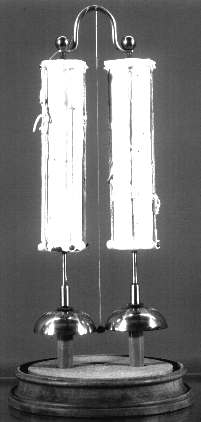Exhibit 1 - The Clarendon Dry Pile

The Clarendon Dry Pile was purchased by Robert Walker (Professor of physics 1839 - 1865) and bears the label in his handwriting "Set up in 1840", though a later note indicates that it may have been constructed some 15 years earlier. It consists of two voltaic "dry-piles", covered with an insulating layer of sulphur, connected in series and, at their lower ends, to two bells. Between the bells is suspended a metal sphere about 4mm in diameter which is attracted alternately by the bells and transfers charge from one to the other. The frequency of its oscillation is about 2Hz; so far the bells have been rung of the order of 10 billion times.
The internal construction of the piles themselves remains a matter for conjecture, but records of similar popular curiosities of the period e.g. Zamboni piles, indicate that they are probably of alternate layers of metal foil and paper coated with manganese dioxide.
Some published reports of the Pile unfortunately refer to it as an example of perpetual motion but the Guinness Book of Records has it under the "worlds most durable battery" delivering "ceaseless tintinnabulation". It is seen but not heard as the ringing is muffled, in the ground floor display cabinet near the main entrance of the Clarendon Laboratory.
